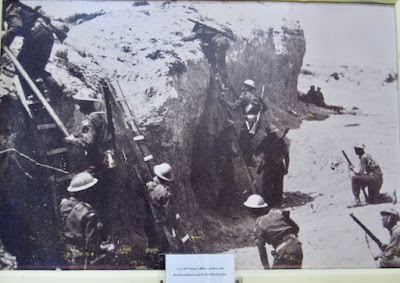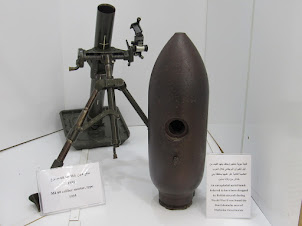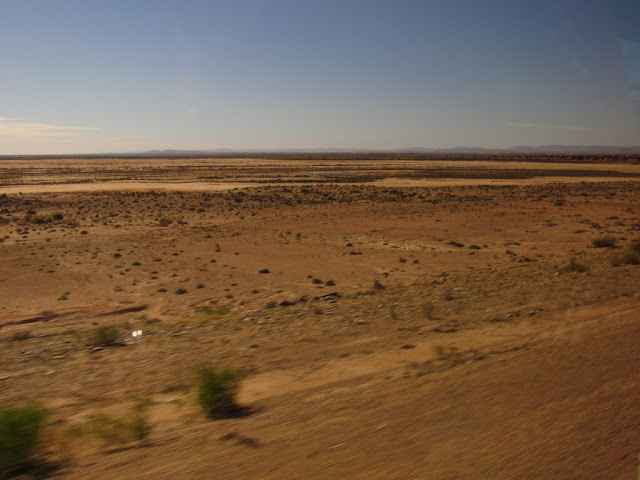The Mareth Line Museum is located in Mareth, located between Gabes and Medenine where a critical battle took place in March 1943. German Field Marshal Erwin Rommel used this bunkered line to resist British Field Marshal Bernard Montgomery's VIIIth army advance. The Museum is built on a hill overlooking the steep banks of the Wadi Zigzaou, near several military pillboxes that were strong points of the defensive line. Command posts, anti-tank and anti-aircraft guns are displayed outside the museum. Inside are uniforms, photos, guns, soldiers' items, and Rommel's jeep. The above monument recognizes the battle.
The battle was a fight for Tunisia's resources. Actually, this struggle went back to 1936 when France and Italy each sought to dominate the area. Italy had built a 40-kilometer defensive line. When Paris fell in 1940, the French left. Tunisia was then occupied by Axis forces after Operation Torch
in 1942, and the line was refurbished and extended by Axis engineers
into a defensive position by building more defenses between the line and
Wadi Zeuss 3.5 mi to the south
The Mareth Line was a system of fortifications built by France in southern Tunisia in the late 1930s. The line was intended to protect Tunisia against an Italian invasion from its colony in Libya. The line occupied a point where the routes into Tunisia from the south converged, leading toward Mareth, with the Mediterranean Sea to the east and mountains and a sand sea to the west.
We drove from Tunis in the north to the Mareth Line in the south. We stopped at the Museum on our way to Djerba Island.
The split screen shows Americans landing in Morocco (left) and Tunisia (right). These troops were largely inexperienced and the North African front was used as their training ground for war on the European continent.
British troops (left) and French troops (below) led the battle in Tunisia.
Rommel's Panzer division was famous and formidable.
 Erwin Rommel (1891-1944), popularly known as The Desert Fox, was a German field marshal during World War II. He was a highly decorated officer in World War I, especially for his actions on the Italian Front. In 1937, he published Infantry Attacks, his book on military tactics that drew on his experiences in that war.
Erwin Rommel (1891-1944), popularly known as The Desert Fox, was a German field marshal during World War II. He was a highly decorated officer in World War I, especially for his actions on the Italian Front. In 1937, he published Infantry Attacks, his book on military tactics that drew on his experiences in that war.
He commanded the 7th Panzer Division during the 1940 invasion of France. His leadership of German and Italian forces in the North African campaign established his reputation as one of the ablest tank commanders of the war. He later commanded the German forces opposing the Allied cross-channel invasion of Normandy in June 1944.
Although he gradually came to support Hitler before the war, Rommel was involved in the July 20, 1944, plot
to assassinate the dictator. Rommel's status as a national hero forced
Hitler to eliminate him quietly rather than execute him immediately as many other plotters were. Rommel was given a choice
between suicide or a
trial that would result in his disgrace and execution. He chose the
former and took a cyanide pill.
Rommel was given a state funeral, and the cover-up that he had
succumbed to injuries from the strafing of his staff car in
Normandy.
War without Hate
Rommel
had a reputation for
chivalry, and his phrase "war without hate" was used
to describe the North African campaign.
Although a number of historians have rejected the phrase as a myth,
other historians note that there is no clear evidence Rommel was
involved in or aware of war crimes or atrocities. Some even point out
that the war in the deserts of North Africa came as close to a clean
fight as there was in
World War II.
Rommel's staff car in North Africa
Military equipment used in Tunisia



Resources
Rommel -- https://en.wikipedia.org/wiki/Erwin_Rommel
Mareth Line -- https://en.wikipedia.org/wiki/Mareth_Line













No comments:
Post a Comment